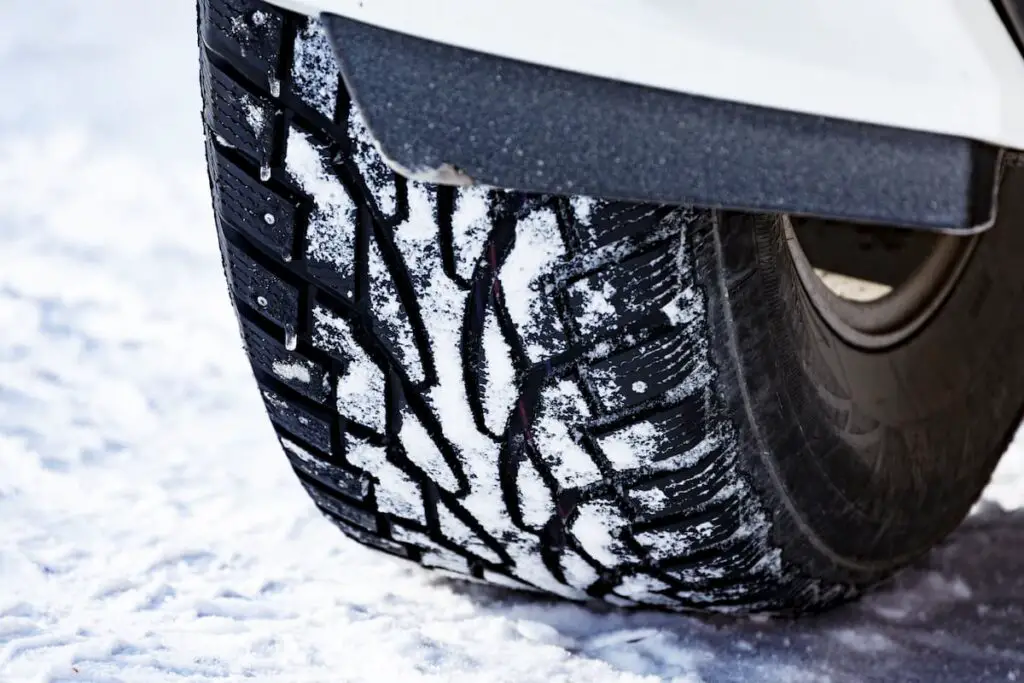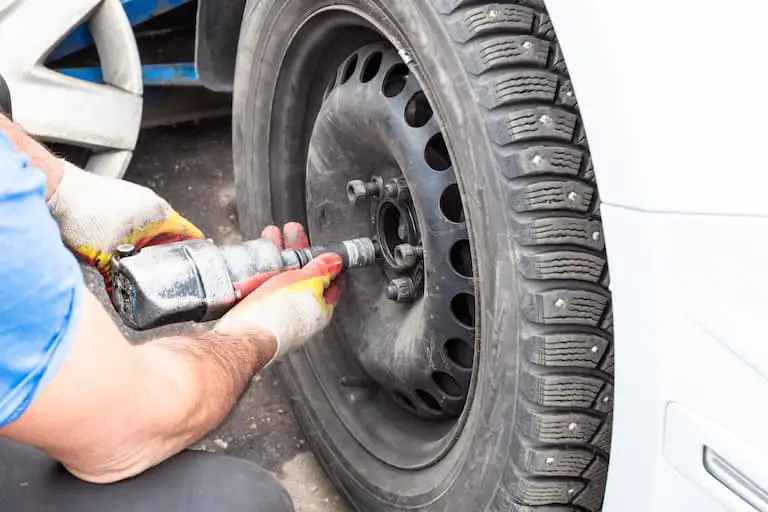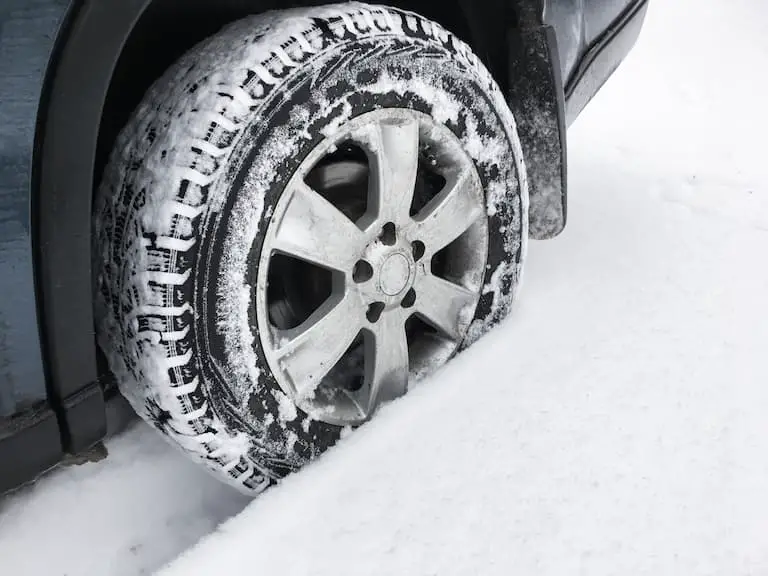As an Amazon Associate, we earn from qualifying purchases. We may also earn commissions if you purchase products from other retailers after clicking on a link from our site.
Winter is coming soon, and you’re ready to switch to the studded winter tires. Then you notice the worn-down studs. So now what—do you use them anyway, or can they be restudded?
Snow tires can be restudded, but doing so is rare because of the challenge of inserting new studs to the proper depth once the tread has worn down. Most tire shops won’t restud tires because they cannot guarantee the work, so you will have to do it yourself or find a small shop that will.
It seems like a waste to get rid of tires, but studded tires shouldn’t last more than several seasons. So before you get started, find out why people recommend against it. Then, if you are not convinced, read on to see how much work goes into the process.

Restudding Snow Tires
Just because you can restud snow tires, you need to consider if it is something you should do. You might be able to find a local tire shop that will do it, but chain stores will not restud tires because of the potential problems.
Manufacturers design studs to wear at the same rate as the tire’s tread. As a result, a stud’s ability to cut into the ice is kept as the tire wears. However, like with other winter tires, once studded tires have worn down to around 5/32″ to 6/32″ of tread depth, they will lose their effectiveness, and you should get a new set of winter tires.
- First, when removing the studs, there’s a possibility that you created a small tear. If the tread is worn, the studs will get driven further down, causing the potential for a leak.
- Removing the old studs can cause new ones not to fit correctly. If that is the case, you’ll need to drill new holes into the tread, leading to possible leaks.
- The new tires will not fit as snuggly. Also, there are various ways they could pop back out.
Due to the complications, car dealerships and major tire outlets won’t restud tires because they cannot warranty their work. However, an independent store, Alaska Tire Service, advertises they restud tires. Still, unless you live or are willing to travel to Alaska, their services will not be helpful.
You might be able to find a small tire shop willing to replace and restud your tires. If not, you might have to do it yourself.
Does this mean that people don’t restud their tires? No. There are folks on discussion threads that claim they have done so, but they are in the minority.

How To Remove the Studs
To remove studs, you need several tools. Most of these you should have lying around your home.
- Liquid wrench, WD-40, or liquid soap
- A stud removal tool of your choice (small flat-head screwdriver and hammer, needle nose pliers, or stud removal tool)
- Safety glasses.
After you gather your tools, you’re ready to get started.
- First, remove the tires. Although removing the studs is possible without doing so, the task is much easier and safer when the tires are not attached to your vehicle.
- Apply a lubricant to the studs. A liquid wrench or WD40 will work best. However, some people claim that liquid dish soap works better. Squirt a small amount of lubricant on the stud.
- Pop out the studs. Use one of these three removal methods listed below.
- Examine the threads for damage. Check the tire for damage before putting the wheel back on the automobile. To check for potential leaks, spray some soapy water on the tread. Press on the tread, and if bubbles form, the tire might have a leak.
- Put that wheel on. Repeat the process with each tire. Don’t forget to tighten the lug nuts.
Three Methods for Removing the Studs
- Flathead screwdriver. If you’re using a screwdriver, push it on the side of the stud until you reach the bottom edge. To get under the rim, tilt the screwdriver to pop out the stud.
- Needle-nose pliers. Grab the stud by the tip with the needle-nose pliers, press down on the stud, and gently twist the stud out and lose.
- Stud removal tool. The circular tip of a stud removal tool fits over the stud for easy removal. First, push the device over the stud until it is under the edge. Then twist the stud, push it to the side, and pop it out.
Stud removal tools are inexpensive and less likely to damage your tire. The Interstate Pneumatics Tire Removal Tool (available on Amazon.com) has a 4-inch (10.16 cm) stem, long enough for all but the largest tires.
How To Install Tire Studs
Installing tire studs can be easily done if you have a stud gun. These expensive pneumatic guns (most around 500 dollars) are one reason that many folks let a tire stop installing the studs. Installation is simple if you have a compressor and can find a reasonably priced stud gun.
- Put the studs in the self-loading hopper.
- Attach the hopper to the gun.
- Put lubricant on the tire.
- Hold the stud gun perpendicular to the tire and pull the trigger.
You should check that the studs are going into the tire at the proper distance. If they stick out more than 1 mm (1/16 inch), they are likely to come out as you drive, but they lose effectiveness if you sink them into the tire.
Once again, most people recommend tires not be restudded because it is challenging to get the depth right in worn holes.
Should You Get Snow Tires or Studded Tires?
Whether you should get snow or studded tires depends on where you live and the type of snow and ice you drive on. Snow tires are more popular for several reasons, partially because they are more flexible.

Studded tires effectively grip icy winter roads, so studded tires will be a good option if you frequently drive on these types of roads. Those small studs effectively “glue” the vehicle to the road by penetrating the ice to obtain traction. Therefore, compared to typical winter tires, you’ll notice a significant difference in how your car handles.
Studded tires keep traction on icy roads, but they are less effective on wet, snowy streets. While studded tires penetrate and grip hard ice, they can’t grab on wet roads.
Furthermore, if you travel on non-snowy roads with studded tires, you’ll notice that they’re pretty noisy due to the metal studs. Unfortunately, studded tires also harm the roads you travel, so some states prohibit them, and others limit their use to several months of the year.
Bottom Line
Although it is possible to restud winter tires, there are several important reasons you shouldn’t. Most tire shops won’t do it for you, the tools to put in studs can be expensive, and the process can be time-consuming. It also may not be as effective as you hope.
